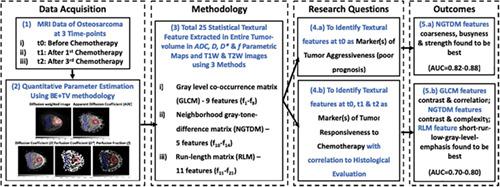当前位置:
X-MOL 学术
›
NMR Biomed.
›
论文详情
Our official English website, www.x-mol.net, welcomes your
feedback! (Note: you will need to create a separate account there.)
Texture analysis for chemotherapy response evaluation in osteosarcoma using MR imaging
NMR in Biomedicine ( IF 2.7 ) Pub Date : 2020-10-20 , DOI: 10.1002/nbm.4426 Esha Baidya Kayal 1 , Devasenathipathy Kandasamy 2 , Kedar Khare 3 , Sameer Bakhshi 4 , Raju Sharma 2 , Amit Mehndiratta 1, 5
NMR in Biomedicine ( IF 2.7 ) Pub Date : 2020-10-20 , DOI: 10.1002/nbm.4426 Esha Baidya Kayal 1 , Devasenathipathy Kandasamy 2 , Kedar Khare 3 , Sameer Bakhshi 4 , Raju Sharma 2 , Amit Mehndiratta 1, 5
Affiliation

|
The efficacy of MRI‐based statistical texture analysis (TA) in predicting chemotherapy response among patients with osteosarcoma was assessed. Forty patients (male: female = 31:9; age = 17.2 ± 5.7 years) with biopsy‐proven osteosarcoma were analyzed in this prospective study. Patients were scheduled for three cycles of neoadjuvant chemotherapy (NACT) and diffusion‐weighted MRI acquisition at three time points: at baseline (t0), after the first NACT (t1) and after the third NACT (t2) using a 1.5 T scanner. Eight patients (nonsurvivors) died during NACT while 34 patients (survivors) completed the NACT regimen followed by surgery. Histopathological evaluation was performed in the resected tumor to assess NACT response (responder [≤50% viable tumor] and nonresponder [>50% viable tumor]) and revealed nonresponder: responder = 20:12. Apparent diffusion coefficient (ADC) and intravoxel incoherent motion (IVIM) parameters, diffusion coefficient (D), perfusion coefficient (D*) and perfusion fraction (f) were evaluated. A total of 25 textural features were evaluated on ADC, D, D* and f parametric maps and structural T1‐weighted (T1W) and T2‐weighted (T2W) images in the entire tumor volume using 3D TA methods gray‐level cooccurrence matrix (GLCM), neighborhood gray‐tone‐difference matrix (NGTDM) and run‐length matrix (RLM). Receiver‐operating‐characteristic curve analysis was performed on the selected textural feature set to assess the role of TA features (a) as marker(s) of tumor aggressiveness leading to mortality at baseline and (b) in predicting the NACT response among survivors in the course of treatment. Findings showed that the NGTDM features coarseness, busyness and strength quantifying tumor heterogeneity in D, D* and f maps and T1W and T2W images were useful markers of tumor aggressiveness in identifying the nonsurvivor group (area‐under‐the‐curve [AUC] = 0.82‐0.88) at baseline. The GLCM features contrast and correlation, NGTDM features contrast and complexity and RLM feature short‐run‐low‐gray‐level‐emphasis quantifying homogeneity/terogeneity in tumor were effective markers for predicting chemotherapeutic response using D (AUC = 0.80), D* (AUC = 0.80) and T2W (AUC = 0.70) at t0, and D* (AUC = 0.80) and f (AUC = 0.70) at t1. 3D statistical TA features might be useful as imaging‐based markers for characterizing tumor aggressiveness and predicting chemotherapeutic response in patients with osteosarcoma.
中文翻译:

使用磁共振成像评估骨肉瘤化疗反应的纹理分析
评估了基于 MRI 的统计纹理分析 (TA) 在预测骨肉瘤患者化疗反应中的功效。在这项前瞻性研究中分析了 40 名经活检证实的骨肉瘤患者(男性:女性 = 31:9;年龄 = 17.2 ± 5.7 岁)。患者被安排在三个时间点接受三个周期的新辅助化疗 (NACT) 和弥散加权 MRI 采集:基线 (t0)、第一次 NACT 后 (t1) 和第三次 NACT 后 (t2),使用 1.5 T 扫描仪。8 名患者(非幸存者)在 NACT 期间死亡,而 34 名患者(幸存者)完成了 NACT 方案,随后进行了手术。在切除的肿瘤中进行组织病理学评估以评估 NACT 反应(反应者 [≤50% 存活肿瘤] 和无反应者 [>50% 存活肿瘤])并显示无反应者:反应者 = 20:12。ADC ) 和体素内非相干运动 (IVIM) 参数、扩散系数(D )、灌注系数 ( D* ) 和灌注分数 ( f ) 进行了评估。共评估了 25 个纹理特征,对ADC、D、D*和f使用 3D TA 方法灰度共生矩阵 (GLCM)、邻域灰度差异矩阵 (NGTDM) 和游程长度在整个肿瘤体积中的参数图和结构 T1 加权 (T1W) 和 T2 加权 (T2W) 图像矩阵 (RLM)。对选定的纹理特征集进行接受者操作特征曲线分析,以评估 TA 特征(a)作为导致基线死亡率的肿瘤侵袭性标志物和(b)在预测幸存者的 NACT 反应中的作用治疗过程。研究结果表明,NGTDM 具有粗糙性、繁忙性和强度,可量化D、D*和f 中的肿瘤异质性图和 T1W 和 T2W 图像是识别非存活组(曲线下面积 [AUC] = 0.82-0.88)基线时肿瘤侵袭性的有用标志物。GLCM 特征对比度和相关性、NGTDM 特征对比度和复杂性以及 RLM 特征短期低灰度级强调量化肿瘤中的同质性/异质性是使用D (AUC = 0.80)、D* ( AUC = 0.80) 和 T2W (AUC = 0.70) 在 t0,D* (AUC = 0.80) 和f (AUC = 0.70) 在 t1。3D 统计 TA 特征可能用作基于成像的标志物,用于表征骨肉瘤患者的肿瘤侵袭性和预测化疗反应。
更新日期:2020-10-20
中文翻译:

使用磁共振成像评估骨肉瘤化疗反应的纹理分析
评估了基于 MRI 的统计纹理分析 (TA) 在预测骨肉瘤患者化疗反应中的功效。在这项前瞻性研究中分析了 40 名经活检证实的骨肉瘤患者(男性:女性 = 31:9;年龄 = 17.2 ± 5.7 岁)。患者被安排在三个时间点接受三个周期的新辅助化疗 (NACT) 和弥散加权 MRI 采集:基线 (t0)、第一次 NACT 后 (t1) 和第三次 NACT 后 (t2),使用 1.5 T 扫描仪。8 名患者(非幸存者)在 NACT 期间死亡,而 34 名患者(幸存者)完成了 NACT 方案,随后进行了手术。在切除的肿瘤中进行组织病理学评估以评估 NACT 反应(反应者 [≤50% 存活肿瘤] 和无反应者 [>50% 存活肿瘤])并显示无反应者:反应者 = 20:12。ADC ) 和体素内非相干运动 (IVIM) 参数、扩散系数(D )、灌注系数 ( D* ) 和灌注分数 ( f ) 进行了评估。共评估了 25 个纹理特征,对ADC、D、D*和f使用 3D TA 方法灰度共生矩阵 (GLCM)、邻域灰度差异矩阵 (NGTDM) 和游程长度在整个肿瘤体积中的参数图和结构 T1 加权 (T1W) 和 T2 加权 (T2W) 图像矩阵 (RLM)。对选定的纹理特征集进行接受者操作特征曲线分析,以评估 TA 特征(a)作为导致基线死亡率的肿瘤侵袭性标志物和(b)在预测幸存者的 NACT 反应中的作用治疗过程。研究结果表明,NGTDM 具有粗糙性、繁忙性和强度,可量化D、D*和f 中的肿瘤异质性图和 T1W 和 T2W 图像是识别非存活组(曲线下面积 [AUC] = 0.82-0.88)基线时肿瘤侵袭性的有用标志物。GLCM 特征对比度和相关性、NGTDM 特征对比度和复杂性以及 RLM 特征短期低灰度级强调量化肿瘤中的同质性/异质性是使用D (AUC = 0.80)、D* ( AUC = 0.80) 和 T2W (AUC = 0.70) 在 t0,D* (AUC = 0.80) 和f (AUC = 0.70) 在 t1。3D 统计 TA 特征可能用作基于成像的标志物,用于表征骨肉瘤患者的肿瘤侵袭性和预测化疗反应。











































 京公网安备 11010802027423号
京公网安备 11010802027423号